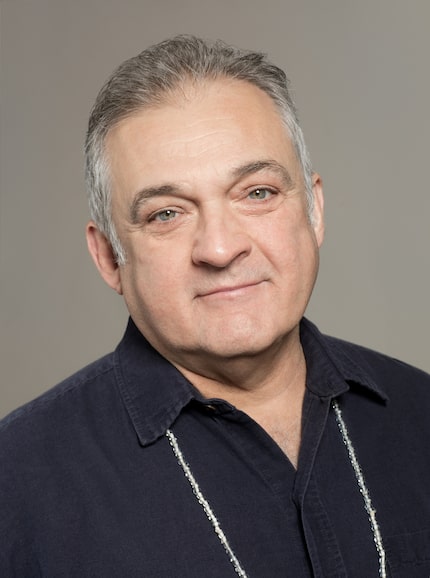Among contemporary choreographers, Mark Morris may be the most musical. He insists on live accompaniment on tour, in rehearsals and in all of the classes taught at his dance center in Brooklyn. The movement in his pieces always grows out of music that inspires him, his range stretching across genres. He’s as comfortable with the Beatles as he is with Mozart.
After a decadelong absence from Dallas presenter TITAS’ seasons, the 68-year-old’s Mark Morris Dance Group returns with The Look of Love, an hourlong work set to 14 songs by prolific 1960s hitmaker Burt Bacharach. Half of them, “What the World Needs Now Is Love,” “Message to Michael,” “Raindrops Keep Falling on My Head,” “Do You Know the Way to San Jose,” “Anyone Who Had a Heart,” Walk on By” and “I Say a Little Prayer,” reached the Top 10.
Premiering in 2022, it’s a kind of follow-up to Pepperland, made in 2017 for the city of Liverpool to celebrate the 50th anniversary of the Beatles’ Sgt. Pepper’s Lonely Hearts Club Band. The Look of Love dresses 10 dancers in brightly colored costumes and the stage with five chairs and five pillows.
Ethan Iverson, Morris’ former music director, connects the tunes into a seamless whole played live by a seven-piece band, including three vocalists led by Marcy Harriell singing Bacharach writing partner Hal David’s lyrics. Before his death last year, Bacharach gave Morris permission to arrange the often darkly romantic songs any way he liked.
“It’s how I would treat any music I use,” he says in a phone interview. “It’s not a tearjerker. It’s not nostalgic. It’s not, ‘Remember when we were young and listened to this music.’ The whole point was to have these great songs and make a wonderful dance show out of them. That’s what we did.”
I talked to Morris about what motivated him to create The Look of Love and how he put it together. The interview has been edited for length and clarity.

Why make a dance to Burt Bacharach songs?
I’ve loved the music forever. They’ve become an acknowledged part of the American songbook. Everybody knows the music somehow, even if it’s just subliminally from hearing it around, because it’s all around all the time. It’s so excellent and varied and complicated. They’re mostly love songs and at least semi-tragic most of the time. They’re very heavy and irresistible. Ethan and I talked about it long before we did Pepperland.
Surprisingly, the songs are very hard to sing. You think you know them, and then you get going and there’s a missing beat or extra phrase. They’re all very unusual and rigorously virtuosic. It’s difficult music, even though it sounds like the easiest thing in the world. They all live happily ever after, but there’s a lot of anguish and ambiguity.
What was Bacharach’s involvement?
We were lucky enough to have met with him a number of times. He was at the dress rehearsal and was really supportive. He gave us full reign.

How did you approach the music?
There’s this genius rhythmicity that he does, amazing rhyme schemes and irregular rhythms, and big melodic and harmonic surprises. There’s a lot of bossa nova in it, Latino elements and jazz.
Not all of the songs are sung, and some have a lot of new material in their arrangements. It’s not that they needed to be freshened. It’s just that we didn’t want to do a greatest hits playlist. It’s a satisfying progression of tempo, keys and male and female singing.
There’s no storyline. Every song has its own situation. So those add up. However you would sequence them, it would turn out a different way.

You include the early song “The Blob” from the 1958 horror film. Why?
Because it’s a funny song that nobody knows. It’s Herb Alpert-y, sort of south of the border, like a surf song. And it’s fabulous. Our treatment is very, very different from the way you can hear it on Spotify. We do it very slow and creepy.
Why do you always use live music in your performances?
Everyone’s used to music being equalized and too loud and exactly the same every time. That’s numbing. You wouldn’t do an opera with a playback track. I want everybody live: audience, performers, ushers, stagehands.
We amplify only to the extent the players can hear themselves and the dancers can hear them on stage. It doesn’t sound like a recording because what’s the point of that? Then it’s a real show, and it won’t happen the same way again.
Details
Nov. 23 at 8 p.m. at Winspear Opera House, 2403 Flora St. $12-$135. attpac.org. titas.org.
Arts Access is an arts journalism collaboration powered by The Dallas Morning News and KERA.
This community-funded journalism initiative is funded by the Better Together Fund, Carol & Don Glendenning, City of Dallas OAC, The University of Texas at Dallas, Communities Foundation of Texas, The Dallas Foundation, Eugene McDermott Foundation, James & Gayle Halperin Foundation, Jennifer & Peter Altabef and The Meadows Foundation. The News and KERA retain full editorial control of Arts Access’ journalism.




